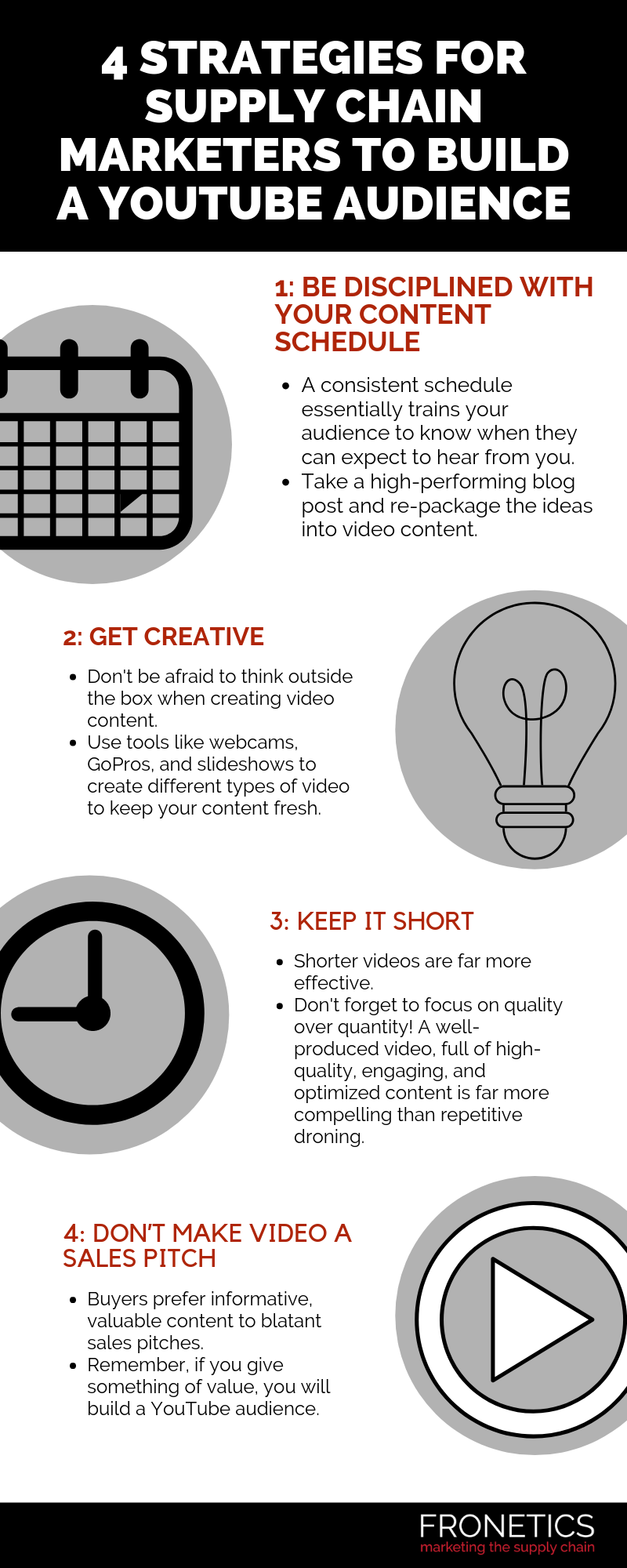
by Fronetics | Apr 9, 2019 | Blog, Content Marketing, Marketing, Social Media, Video Marketing
If you’re trying to build a YouTube audience, you’ll need equal parts strategy, creativity, concision, and valuable subject matter.
Highlights:
- Strategy and creativity are top priorities.
- Keep content short and sweet for maximum impact.
- Offer value to your audience rather than a sales pitch.
An increasing percentage of search traffic is perusing YouTube for information, advice, and education. That makes the platform ideal for getting in front of prospects looking for products and services like yours.
But I’ve seen a lot of B2B marketers getting YouTube wrong. The good news is that the problem is usually that they’re trying too hard — and not in the right ways.
To effectively build a YouTube audience that will eventually become leads and, hopefully, customers, you need to be distributing video content that showcases your organization’s expertise in an approachable way. Here are some simple rules for how to go about that (without barking up the wrong tree).

(Made with Canva)
4 ways to build a YouTube audience
1) Be disciplined about your content schedule.
When it comes to publishing content on social media, when you post is nearly as important as whatyou post. YouTube is no different. Creating and sticking to a consistent schedule for posting new content essentially trains your audience and lets them know when they can expect to hear more from you.
Creating video content consistently doesn’t need to feel like reinventing the wheel. First off, videos should be part of your content calendar in the same way as blog posts, case studies, and other forms of content. You don’t need to create brand new material for each video. Take a high-performing blog post and re-package the ideas into video content.
2) Get creative.
Creativity for B2B companies is all about striking the right balance between entertaining presentation and informative, high-quality content. Think about approaching the information you want to convey in a different way. Can you use a different medium (like animation) or interview two subject-matter experts together if your one-on-one interviews are feeling stale?
There are plenty of technologies available today that will help you create exciting, engaging video content relatively cheaply. Or you could always consider outsourcing your videography.
3) Keep it short.
While we’ve seen recent growth in long-form YouTube content, for most B2B marketing purposes, shorter videos are far more effective. Of course, this is good news in that producing shorter videos can be less time-consuming and costly. But I cannot emphasize enough the importance of quality over quantity here.
[bctt tweet=”A 1- to 2-minute video of high-quality, well-edited content will get far more engagement (and be more successful in helping you build a YouTube audience) than 15 minutes of lecturing or poorly executed, complex animation.” username=”Fronetics”]
A 1- to 2-minute video of high-quality, well-edited content will get far more engagement (and be more successful in helping you build a YouTube audience) than 15 minutes of lecturing or poorly executed, complex animation. If you have a lot of footage about a certain subject, consider releasing a series of shorter videos.
4) Don’t make video a sales pitch.
Content marketing is inbound marketing, and video is no different. Countless studies have shown that increasingly buyers prefer informative, valuable content to blatant sales pitches.
This doesn’t mean that your content shouldn’t be branded, but it does mean that your focus in creation and execution needs to be what you can offer your audience, rather than you’re asking from them.
Use your video content to address specific concerns or answer questions that are relevant to your target audience. It’s simple: if you give something of value, you will build a YouTube audience that could eventually become your leads and customers.
What have you been doing to build a YouTube audience?
Related posts:


by Fronetics | Apr 4, 2019 | Blog, Content Marketing, Marketing
The best way to come up with creative and engaging content is to think outside the box and sometimes, take risks. Here are 4 rules to break to produce truly creative content.
Highlights:
- Throw out the template approach to content and start thinking about what makes you stand out.
- Don’t be afraid to showcase what you do best through different avenues, like customer or vendor testimonials.
- When you’re committed to curiosity, you naturally become a learning organization and this learning leads to more creative content.
Video transcript:
I’m Elizabeth Hines, and I’m the Creative Director at Fronetics, and today we’re talking about for more creative content, you have to break these four rules.
With over 4 million blog posts published every day, you have to be really creative with your content in order to drive traffic and win over prospects and leads.
So in order to do so, you’re going to have to break these four rules.
1. Mirror competitors
If you’re in this certain industry, then you have to cover these certain topics. You might think because your competitors are covering this certain topic or that certain topic, you should be covering it as well. Not so. You should be covering the topics that are unique to your business, that your company offers expertise in and the ways you stand out from your competitors.
2. Marketing mindset
While your marketing team has a great idea of what is going on in your, some of the best stories and the best blog content comes from your other teams. Maybe your sales team, sometimes your customers or your vendors have a really good prospective or a really good story to tell. And some of the most creative content comes from those unique prospectives.
3. Keep it obvious
It can be really tempting to do a quick brainstorm, come up with a couple good ideas, things that are obvious and things that stand out about your company. But you’re going to get much more creative content if you dig a little deeper. For example, if your first instinct is to talk about self-driving vehicles, a very popular topic right now, can you offer a new perspective on that topic? Can you talk specifically about the sensors that are involved in that technology? Can you talk about government regulations of that technology? What new perspective can you offer to that often talked about conversation?
4. Repeat success
Now this is a little bit controversial because I do encourage you to look at what’s been successful in the past and try to build on that and try to repeat that. But you should also be taking some risks when you’re developing your content calendar. Build in a healthy mix of what’s worked for you in the past, what resonates with your target audience. Then something new, something different, something totally out of left field, because you need to keep experimenting. You need to keep trying new things because your audience is going to evolve and your content should evolve creatively as well.
For more information, visit our website at fronetics.com.
Related posts:


by Fronetics | Apr 3, 2019 | Blog, Content Marketing, Manufacturing & Distribution, Marketing, Supply Chain
Here’s why manufacturing marketers should skip the sales pitch and create content that prioritizes the needs of their target audience.
Highlights:
- Research indicates that only about half of manufacturing marketers are prioritizing their audience’s needs when creating content.
- Inbound marketing (like content marketing) is more effective than outbound marketing for B2B businesses.
- A documented strategy will help you get started creating focused, quality content.
One statistic is sticking out to me in the Content Marketing Institute’s Manufacturing Content Marketing 2019: Benchmarks, Budgets, and Trends report. According to the research, half (51%) of manufacturing marketers reported that they always or frequently prioritize their sales/promotional message over their audience’s informational needs when creating content for content marketing purposes.
Let’s think about that for a second.
A preponderance of manufacturing content marketers are, unfortunately, missing the point.
We’ve written before about why inbound marketing, like content marketing, is more effective for the supply chain than more traditional outbound marketing techniques. And while it’s true that “the supply chain is increasingly seeing the value of moving to an inbound marketing strategy,” the CMI’s research suggests that it’s taking some marketers a long time.
Why you should be putting your audience’s informational needs first
Why should you be emphasizing your audience’s informational needs over your promotional goals when creating content?
[bctt tweet=”One of the basic premises of content marketing is the recognition that, increasingly, your customers want much more from you than your product.” username=”Fronetics”]
The short answer is: because your audience prefers it. One of the basic premises of content marketing is the recognition that, increasingly, your customers want much more from you than your product. For manufacturing marketers, this means that customers want value separate from and outside of the sales funnel.
Enter content marketing. Creating effective marketing content relies on accepting that your business has much more to offer than its primary products and services. In fact, your most valuable commodity, as we’ve often said before, isn’t any material or service — it’s the knowledge, expertise, and informed, unique perspectives you have to offer.
Strategize to put customers first
To successfully adjust your content marketing efforts to put your customers’ informational needs first, the first step is having a well-defined, measurable strategy — and documenting it. This means defining precisely who you’re trying to reach and developing a complete target buyer persona(s).
Once you’ve defined exactly who you’re trying to reach, it’s time to identify the unique questions, needs, and challenges this target buyer faces. Chances are, your business has not only the products to meet those needs, but also the information to answer question and offer valuable insights.
One of the benefits of a documented strategy, with clearly stated objectives, is that it allows you to set up metrics and evaluate your successes and shortfalls. This is where you can start listening to your target buyers. You can even solicit responses from them via email and social media that will allow you to target and hone your efforts in the future.
Meeting manufacturing marketers’ challenges
The CMI’s research reinforces the fact that manufacturing marketers face unique challenges. The top reported challenge was “creating content that appeals to multi-level roles within the target audience.”
According to Achinta Mitra, founder of Tiecas, an industrial marketing consultancy, “Buying decisions are made by a committee and very rarely, if ever, by an individual. Some of these stakeholders may never interact with your content or visit your site.”
Essentially, there are various types of buyers with various needs — meaning their content needs are different. Mitra advises bringing “subject matter experts to the forefront, and letting marketing do the heavy lifting in the background.” He bases his advice on the belief that “one engineer to another is a powerful concept for earning trust, gaining credibility, and winning the mindshare of engineers and industrial professionals.”
If you’re thinking beyond downloads when creating content, and truly prioritizing quality information, your content will function broadly throughout the complex manufacturing buyer’s journey.
Related posts:

by Fronetics | Apr 2, 2019 | Blog, Content Marketing, Logistics, Marketing, Supply Chain
Follow these supply chain and logistics blogs to keep up with the latest industry news and happenings.
Highlights:
- These industry blogs are rich with the latest news, insights, and trends.
- Blogs cover a variety of topics, including research and strategy, and feature insights from some of the top thought leaders in the industry.
One of the best ways to keep pace with the latest happenings in the supply chain industry is to follow the right blogs. There’s some great information available out there, and we’ve put together this list of our 10 favorite sources.
These blogs are rich with industry news, insights, and trends. They cover a variety of topics, including research and strategy, and feature insights from some of the top thought leaders in the industry.
10 must-follow supply chain and logistics blogs (in no particular order)
1) Supply Chain 24/7
The Supply Chain 24/7 blog is a top business resource for Transportation, Distribution, Logistics and Supply Chain professionals. Read this blog.
2) Women In Trucking
These two blogs focus on various issues facing women in the trucking industry. WIT President Ellen Voie writes about topics in employment, achievement, and driving change in the industry. The Women In Trucking blog features posts by truckers, mostly industry veteran Sandy Long, about everyday concerns and experiences facing female drivers and their families. Read this blog.
3) Hollingsworth
Using best-in-class warehouse management technology, Hollingsworth offers complete, real-time visibility of the supply chain. The blog focuses on topics ranging from complex order fulfillment strategies to best practices for optimizing supply chain management. Industry tips, new technologies, and the latest strategies are just some of the topics covered in the posts. Read this blog.
4) Supply Chain Brain
This portal for supply chain executives features original and aggregated content touching on multiple industries. Read this blog.
5) Supply Chain Shaman
Lora Cecere’s blog focuses on “the use of enterprise applications to drive supply chain excellence.” Read this blog.
6) Supply Chain Matters
The blog of Bob Ferrari offers his expertise on all aspects of supply chain business processes and supporting information technology. Read this blog.
7) Supply Chain Management Review
This vast website includes trending articles on supply chain and logistics strategies developments, many written by university-level professors. Read this blog.
8) Supply Chain Digital
Supply Chain Digital is a forward-thinking digital community aimed at providing procurement & supply chain professionals with industry-leading news, analysis, features, and reports about the world’s biggest supply chains. Read this blog.
9) Logistics Viewpoint
This blog features think pieces from three leading supply chain and logistics analysts with the mission to provide clear and concise analyses of logistics trends, technologies, and services. Read this blog.
10) EBN Online
This blog features top industry leaders publishing on topics including electronics manufacturing, global supply chain, and management logistics. Read this blog. (P.S. Read our CEO Frank Cavallaro’s blog here.)
What supply chain and logistics blogs are you following lately?
Related posts:


by Fronetics | Mar 28, 2019 | Blog, Content Marketing, Current Events, Logistics, Marketing, Social Media, Supply Chain
Also, this month in social media news: Twitter launches new camera tools to increase visual focus; and Pinterest introduces Catalogs and expands shopping ads.
This month on social media news, we’re seeing a few trends continuing. Platforms are increasingly offering robust analytics tools to content creators in an effort to boost engagement. This time, it’s Twitter rolling out a new tool that gives video publishers insights on optimal post timings. Twitter is also jumping on the “Stories” bandwagon, with its own answer to the trend: a camera feature that allows users to create images similar to Instagram and Facebook Stories.
Also this month, we’re seeing good news for brands when it comes to advertising on social media. Facebook is introducing a feature for premium video advertising, while Pinterest is rolling out multiple tools to help brands sell directly from the platform. Read on for a round-up of social media news.
Social media news for March 2019
Twitter Debuts a New Analytics Tool for Video Publishers
In an effort to provide video publishers with increased data to aid in performance improvement on Twitter, the platform has released the first in a new series of publisher insights tools: Timing is Everything. According to Twitter, the tool “displays historical data showing when audiences are on Twitter watching and engaging with video. This data highlights the best time(s) to Tweet video content with an aim to maximize engagement, conversation, and viewership.”
This is big news for video publishers, including content marketers. Twitter is offering key insights on one of the most important factors in determining social media marketing success: timing. Of course, increased engagement is in the platform’s best interest — and it’s in yours as well. Stay tuned for the release of more insight tools from Twitter in the coming weeks and months.
Facebook Announces Facebook Showcase for Premium Video Advertising
Facebook has debuted Facebook Showcase, a new premium video ad program that gives online video and TV ad buyers participating in the upfront selling cycle new opportunities to reach their target audiences on the platform. Showcase is currently available for campaigns targeting U.S. audiences and includes In-Stream Reserve, In-Stream Reserve Categories, and Sponsorships.
Facebook’s announcement is another big one for advertisers. Showcase will help advertisers connect with people through premium content and unique video experiences and can help reach younger-skewing audiences that are increasingly difficult to reach on TV.
Twitter Launches New Camera Tools to Increase Visual Focus
While platforms like Facebook and Instagram are increasingly ushering users towards their respective Stories features, Twitter is introducing a camera tool which will let users capture Stories-like images, including overlays and a searchable element. In addition to bringing the platform on board with the Stories trend, it ushers in more visual content options.
[bctt tweet=”Twitter is introducing a camera tool which will let users capture Stories-like images, including overlays and a searchable element.” username=”Fronetics”]
Swiping left on your Twitter timeline from your mobile device will take you to the new camera. There you can capture an image or video, or even go Live straight from Twitter, rather than having to be routed through Periscope. Next, users have the option to add details to the image, including hashtags suggested based on location. Stickers and filters aren’t here yet, but no doubt they’ll be coming soon.
Pinterest Introduces Catalogs and Expands Shopping Ads
Pinterest has rolled out a series of new tools and products to help brands sell their products directly on the platform. The company has debuted Catalogs, which allows brands to upload their full product portfolios to Pinterest and easily turn each item into dynamic, shoppable product pins. In addition, Pinterest has introduced personalized shopping recommendations for style, home, beauty, and DIY boards.
The platform’s rollouts are good news for brands and speaks to the company’s pro-business corporate mindset: “People come to Pinterest in a shopping mindset open to discovering products, which creates a great connection between Pinners and businesses. Pinners are looking for inspiration, and brands help make that inspiration a reality.”
What other social media news has your attention this month?
Related posts:


by Jennifer Hart Yim | Mar 27, 2019 | Blog, Content Marketing, Current Events, Leadership, Marketing, Supply Chain, Talent
In today’s job market, companies have to compete harder than ever before and candidates, realizing their position, have begun ghosting employers. Ghosting has never been in an issue in the professional setting until now.
Highlights:
- According to a new report, more companies and recruiters are getting ghosted, with thousands of users on LinkedIn chiming in about what seems to be a uniquely-millennial phenomenon moving into the workplace.
- Ghosting’s prevalence speaks to a talent attraction and retention problem that many companies are having in this marketplace.
- Recruiters who are specialized in your vertical have an established base of candidates, so you can remove ghosting from the equation entirely.
This guest post comes to us from Argentus Supply Chain Recruiting, a boutique recruitment firm specializing in Supply Chain Management and Procurement.
Many of us have (thankfully) been out of the dating game long enough that we’ve never experienced what most millennials have: the dreaded ghost. You meet someone new, hit it off, go on a few dates, maybe even tell your friends and parents about an exciting romantic prospect. Then the hammer drops: all of a sudden, radio silence. No “dear John” letter, no break-up text, and no explanation whatsoever. It’s a digitally-enabled way of severing ties that’s so casual it hurts, because the affected (dare we say victim?) never gets to find out what exactly happened. The imagination runs wild with possible motivations for this disrespect: was it them? Was it me?
You never really know. That’s what makes it so tough.
Now, according to reports, this peculiar social phenomenon has metastasized into the workplace:
The job market is so hot, more candidates are ghosting their employers. Or prospective employers.
Welcome to 2019.
It’s no secret that the hiring market is strong, with near-historic low levels of unemployment. Now, according to a recent NPR report, more companies and recruiters are getting ghosted. It’s also become a hot topic on LinkedIn, with thousands of users chiming in about what seems to be a uniquely-millennial phenomenon moving into the workplace. Reports about ghosting even made their way into a recent report from the U.S. Federal Reserve – which shows that ghosting isn’t just a meme, but something that’s really affecting companies’ hiring practices and their bottom line.
NPR – as well as this great article by LinkedIn Contributor Molly Mosley – identify three key species of ghost:
- The employee who accepts a role and gets into the job – thankfully, it’s not often a long-term employee, otherwise a missing person report might be in order – and leaves without a trace.
- The job candidate who books a job interview, or accepts a role, and doesn’t show up, or send any kind of communication or response when contacted.
- The candidate who works with a recruiter, asks to be submitted for a role, and then stops responding. There are quite a few reports about this, but we’re lucky that we haven’t experienced it as much in our recruitment practice at Argentus.
Ghosting is a very modern-feeling phenomenon. It’s a symptom of a more relaxed – dare we say, lax – approach to interpersonal and professional relationships brought about by digital technology. But it’s also a symptom of something more fundamental about this job market:
It’s a candidate’s market – especially in high-demand STEM fields like Supply Chain.
We’re willing to bet that in a recession, all these ghosts would become corporeal again. But for now, candidates have all the leverage, and what’s more, they’re beginning to realize this, which means that companies have to compete harder than ever before.
Don’t get us wrong: ghosting is unacceptable, and we don’t mean to excuse it. No one would want to hire a candidate who’s ghosted an employer in the past, and we’d stop working with anyone if we found out they’ve done it before. It’s, in short, the height of unprofessionalism. Any company who gets ghosted on has really dodged a bullet: who would want to work with someone who would resort to such a childish and cowardly tactic?
But ghosting’s prevalence still speaks to a talent attraction and retention problem that many companies are having in this marketplace. Consider this: if your company interviews someone, and never gives any form of feedback or follow-up – which still happens, believe it or not – you’re ghosting candidates as well.
It cuts both ways. And that gestures towards a few changes that companies can make to help minimize the risk of ghosting – which can waste thousands of dollars of company resources:
Smooth out the onboarding process.
In short, treat prospective candidates like a valuable strategic asset instead of a disposable endless resource. The accounts of ghosting from the workers in the NPR story, as well as others, share something in common: the workers felt disrespected or disregarded by their employers.
[bctt tweet=”The accounts of ghosting from the workers in the NPR story, as well as others, share something in common: the workers felt disrespected or disregarded by their employers.” username=”Fronetics”]
Treating candidates with respect is table stakes in this hiring environment. But consider the ways that you’re unintentionally depersonalizing the hiring and onboarding process: letting it get drawn out with endless approvals and interviews, resorting to impersonal communication methods, failing to have succinct and effecting onboarding policies to get new candidates up to speed.
Lastly, because we can’t resist: a specialized recruitment partner will forward pre-vetted candidates, often ones that they’ve known for years, who you know won’t ghost. Recruiters who are specialized in your vertical have an established base of candidates, so you can remove ghosting from the equation entirely.
But what’s your experience? Have you been ghosted by an employee or job candidate before? Why do you think this issue is coming into the zeitgeist right now?
Related posts:












